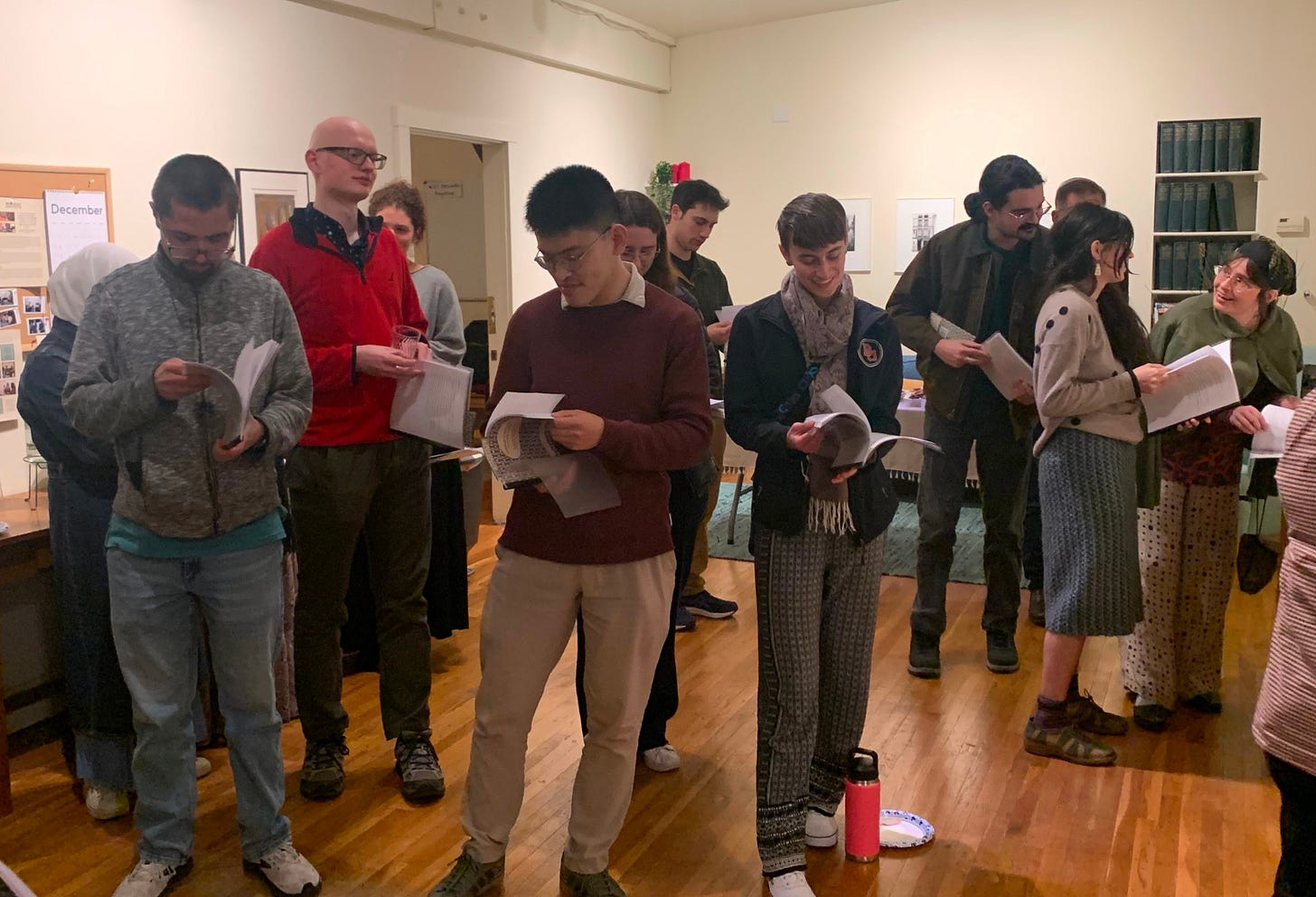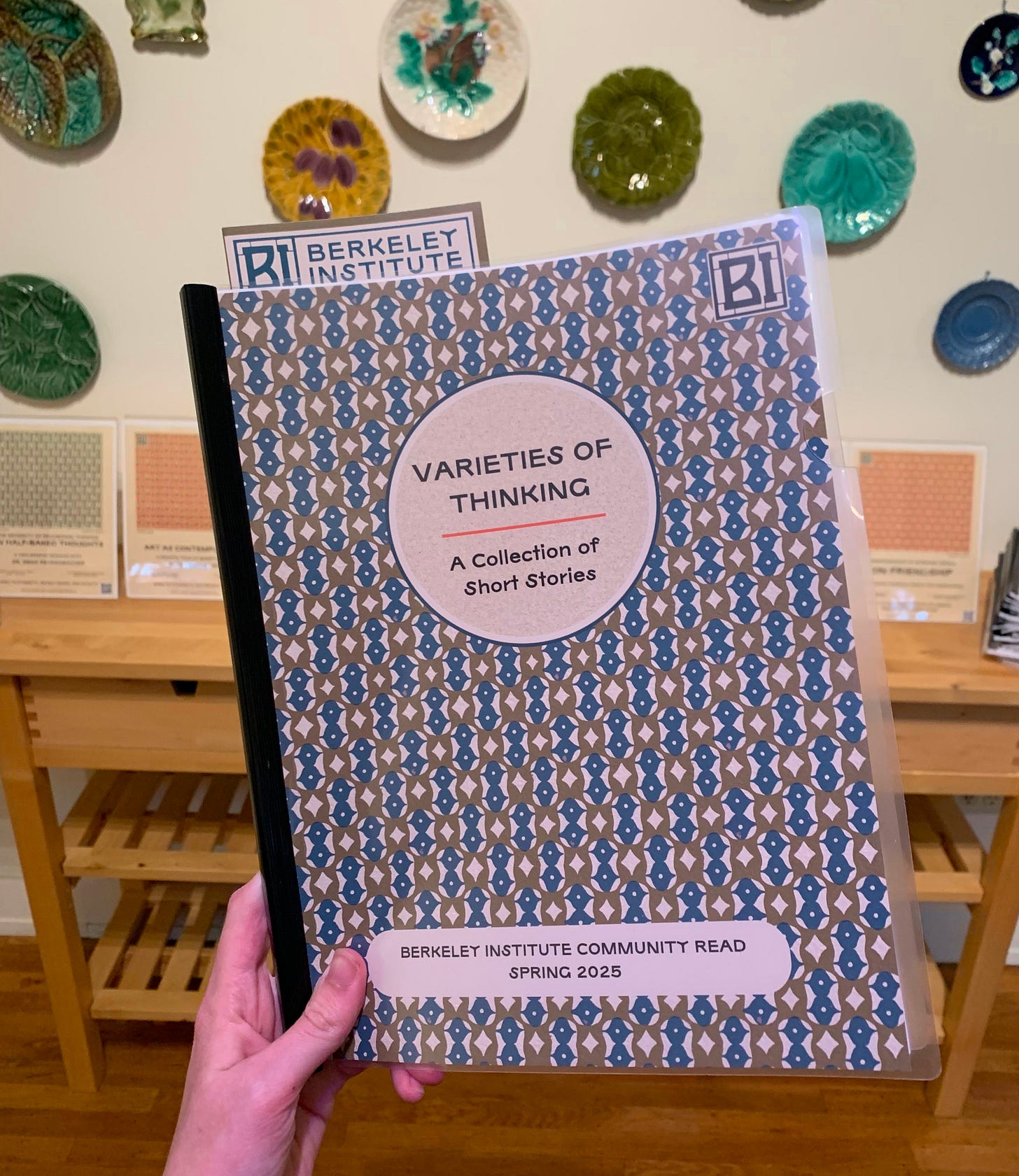Spring 2025 Theme: Varieties of Thinking
We know we need to learn "critical thinking." What other kinds of thinking are also necessary for good intellectual work and the ability to live well in the world with others?
The Berkeley Institute’s Spring 2025 Semester Theme is Varieties of Thinking, paired with our Spring 2025 Community Read, a collection of short stories. Students can pick up a copy of the Reader at the Berkeley Institute or download at the link further down in this post. We invite all our community to join us for four Fridays this semester (starting this week!) to discuss the stories from our reader. This Friday we’ll be discussing “Cathedral” by Raymond Carver and “The Handsomest Drowned Man in the World” by Gabriel García Marquez.
Below, we’re sharing the content from our Spring 2025 Semester guide, which lays out the questions we will ask across this semester and why we chose these texts.
Be sure to check out our themed semester program offerings, which features events for students, faculty, and Friends of the Berkeley Institute. Members of our BINST Alumni Association are also invited to join in virtual discussions of our community read this semester. Finally, subscribe to receive monthly-ish updates on what we’re doing and thinking about.
Our 2025 Spring Semester Theme:
Varieties of Thinking
The Berkeley Institute is devoting the Spring 2025 semester to exploring “Varieties of Thinking” by reflecting on what is required of us to think well. We will discuss select categories of thinking — contemplative, reflexive, imaginative, critical, speculative — and ask: What is the value of different types of thinking? How are different kinds of thinking practiced and accounted for? And how can thinking be an act — that is, something we deliberately undertake?
University education is often valued for teaching “critical thinking,” but other kinds of thinking are also necessary for good intellectual work and our ability to live well in the world with others. We ask the above questions with the awareness that different kinds of thinking are not discrete, boundaried or exclusive; in fact, modes of thinking overlap with or require each other. Different disciplinary norms shape how we understand what thinking itself is (e.g. thinking vs. cognition), as do different intellectual, philosophical and religious traditions. Hence, our questions and selections are meant to simply commence an exploration of what is required to think well; in our programming, we’ll explore the specificities of individual traditions and formulations of thinking in all its diversity.
Finally, we ask these questions as contemporary technologies invite us to outsource certain kinds of thinking. What kinds of thinking cannot – or should not – be outsourced? What kinds of thinking are central, and perhaps undervalued features of human experience and flourishing lives?
Our Spring 2025 Community Read: A Collection of Short Stories Inspiring Reflection on Varieties of Thinking
Why Short Stories?
Short stories don’t necessarily tell us what or how to think, but they can render the act of thinking itself, making it available as an object of thought, imagination, and contemplation. In order to become more conscious and deliberate about our thinking, it helps to know what different types of thinking look and feel like. Rather than ordering thought into an argument, the short story arranges it — and the mental, emotional, and somatic sensations that accompany it — in the order in which we experience it. In doing so, fiction illustrates the need for thinking by exploring the limits of our ability to do so: how it can go wrong or be done badly, or how we can refuse to think altogether. So fiction can show us how not to think, but it also helps us consider how our thinking could be conducted differently.
Our Spring 2025 Community Read is a collection of short stories that inspire reflection on varieties of thinking:
Imaginative Thinking:
“Cathedral” by Raymond Carver and “The Handsomest Drowned Man in the World” by Gabriel García Marquez
Reflexive Thinking:
“Good People” by David Foster Wallace and “What I Have Been Doing Lately” by Jamaica Kincaid
Critical Thinking:
“Foucault and Pencil” by Lydia Davis and “A Novel in Nine Letters” by Fyodor Dostoevsky
Contemplative Thinking:
“Evensong” by Laurie Colwin and “Signs and Symbols” by Vladimir Nabokov
Speculative Thinking:
“The Secret Miracle” by Jorge Luis Borges and “The Last Question” by Isaac Asimov
What to Consider as You Read…
Imaginative Thinking: Perceiving Beyond Seeing
Some philosophers have argued that imagination should not be opposed to seeing; one could say that imaginative thinking is our inner eye, our own capacity to perceive, and to perceive beyond what we see. How do Marquez and Chandler’s stories explore this? What role does imaginative thinking play in social life?
Reflexive Thinking: Thinking about Thinking
If reflexive thinking includes thinking about one’s own thoughts, what challenges do Wallace and Kincaid’s protagonists encounter in trying to do so? How might reflexive thinking resist representation across linear narrative time?
Critical Thinking: A Kind of Problem Solving
If an aspect of critical thinking is the intellectualization of a problem that needs solving, how does Dostoevsky’s story communicate the need for a kind of thinking that his characters are incapable of? What impedes their ability to think “critically”? And how does Davis’ story imagine a way of dealing with obstacles to critical thinking and comprehension?
Contemplative Thinking: Thinking that Receives
If we focus on contemplative thinking as receptive thinking, as thinking that receives but does not analyze, what is the purpose of contemplative thinking? In Colwin and Nabokov’s stories, what knowledge and practices does it require?
Speculative Thinking: Suspending Assumptions
Speculative thinking involves temporarily holding certain conceits about the world, trying them on and exploring what thinking under such conceits can yield. What conceits do Borges and Asimov’s short stories require, and what does thinking under those conceits yield?








